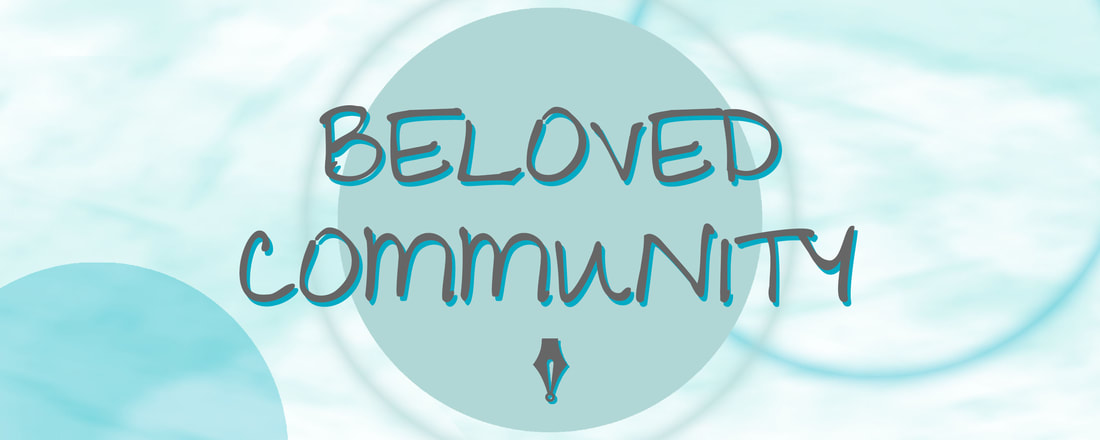|
At Humanities Amped in 2021, we are celebrating the first of our three core values: beloved community. As we look toward the future and its challenges, this aspect of our organizational vision, to nurture a dynamic, beloved community of lifelong learners and civic leaders, has never felt more essential to our individual and collective well-being. Over the next few months, we will release a series of think pieces reflecting on the theme of beloved community and how it shows up in our work at Humanities Amped. Click here to learn more about the heart of beloved community and why it matters so deeply to us.
Passing the (Virtual) Talking PieceDestiny Cooper & Emma GistAs students walked into our very first Amped class in 2014, they chose their place in the circle. With the intention to question schooling as it is and its corresponding structures of power, we welcomed our new students, established June Bug Productions’ story circle process, shared our seed stories, and listened in awe as person after person shared their story with this group of near strangers. From within that circle, where we offered our stories and established shared power as equal learners and teachers regardless of age or degree, we began to build a Beloved Community. Throughout the year our students realized more power and self-trust by vulnerably building community, grappling with academics, and leaning into social risks. We noticed, however, that challenging existing power structures provoked people’s insecurities and hopelessness, which in turn led to an increase in conflict between and among teachers and peers. After attempting to use the tools from our combined decades of classroom and youth development experiences, we realized that we needed a more structured and purposeful method to build a positive community and prevent conflict, not just respond to it.
We learned to use circles to build community about four times more often than to respond to harm and dedicated more time to using circles to live our values, process our challenges, and celebrate our triumphs. We not only saw less conflict, but we also witnessed more student ownership and growth as young leaders. As we developed our students’ capacities to design and facilitate circles for their peers and adults, we also incorporated circles into professional development sessions, staff meetings, and community events because in Amped circles are not a trendy classroom strategy: they are a practice that allows us to live in our values while in relationship with one another.
Translating processes for in-person circles into virtual spaces requires, like any virtual transition, adaptability. At the most basic, entering a virtual classroom and assuming a place in a grid of icons is enormously different from the experience of entering a classroom and taking a seat in a physical circle, where Beloved Community is concretized as the best version of seeing and being seen. Based on our experiences, working through these challenges, we have developed the following guidelines for hosting circles in virtual spaces: The Virtual Circle Process1. As participants enter the virtual room, the facilitator(s) create, record, and announce an order of speakers, sharing the list of names with participants using the chat function. If people enter the room late, their name should be added to the circle order. While circle orders are obvious in person, online spaces require a circle order that can be visually referenced throughout the process. Explicit circle orders provide structure and clarity of expectations. 2. The facilitator welcomes the participants into the circle, reviews the circle guidelines, and explains that although the “talking piece” may be invisible, its function of ensuring only one person speaks at a time still applies. The facilitator explains that to simulate passing a physical object from person to person, each participant will verbally say “I pass the talking piece to [next person in the speaking order].” Using the phrase “I pass the talking piece to…” is a way to distribute facilitative power to the circle participants, who control the process without waiting to be called on by someone who is “in charge.” 3. The facilitator presents the first question or prompt. If the facilitator’s name is first in the speaking order, they will model the process of responding and passing the talking piece. Alternatively, they will ask the first person in the speaking order to begin in the process of responding and passing. While the facilitator may model the process, when possible, it can be effective to approach a trusted and willing participant ahead of time and ask them to be the first to answer. 4. After offering their response, each participant passes to the next person in the speaking order. If a speaker forgets to pass, the facilitator can prompt, “And you pass to…” Rather than simply calling on the next person, this strategy empowers the participants to guide the circle process. 5. If necessary, the facilitator reminds the participants that it is always acceptable to pass on a question or prompt. The person passing should simply pass to the next person in the speaking order. Circle processes are not effective if participants feel forced to engage. We operate within our value of trust when we allow people to decide whether or not they want to share. 6. The last speaker in the circle always passes back to the facilitator or first person in the circle order. The facilitator then offers an opportunity to share to anyone who passed. Often, participants who passed initially will feel ready to share once everyone else has spoken. If those who passed are still reluctant, the facilitator can offer the option of borrowing from, or echoing, someone else’s response. However, it is important to allow participants to pass a second time if they do not want to respond. 7. The facilitator then presents the next question or prompt. The participants respond using the same circle order and processes. While this round may begin with the same person as the previous round, the facilitator might choose someone else to go first, or ask for volunteers. Whoever’s name is last in the circle order would simply pass to the person whose name is first 8. After the final round, the facilitator thanks the group for engaging the circle and celebrates any challenges that were met. For example, the facilitator may have offered a challenge of 100% participation by the end of the process. For a challenge like this, it is important to recognize that participation may look like an out-loud response or a response in the chat. We first began implementing these online circle practices on a large and consistent scale at our fully virtual Amped Summer Institute. During these two weeks of deep community building and learning, Amped educators, staff members, and youth engaged regularly in circle processes. Teachers who participated in circles in the Summer Institute haved designed and facilitated circles for their classes, opening up spaces for each student to see and be seen, to express their ideas, and be honored for their contributions.
The following protocols are fundamental to the formation and ownership of positive community and should be honored in the translation from in-person to virtual and hybrid spaces:
Because we believe in the power of circles both in the classroom and beyond it, we have continued to implement them across our organization: we have designed and hosted circles for teacher reflection, for community connection, for district-wide professional development, in staff and board meetings, in collaborative planning sessions, and in after-school settings. By committing to these practices, especially at a time when virtual life has felt, for many, unproductive and miserable, we have been able to shape interactions that center trust, inclusion, and joy. • We invite you to visit our Amplified Classrooms curriculum on our website for more information about our use of circles, an element of restorative practices, in Amped spaces. Click below to learn more about circle protocols, to access circle templates, and to view professional development videos about applying circles for a variety of classroom contexts.
0 Comments
Leave a Reply. |
|
Contact Us |
Mailing Address7350 Jefferson Hwy
Ste. 485 PMB 130 Baton Rouge, LA 70806 |
© 2024 Humanities Amped
Humanities Amped is a 501(c)(3) nonprofit organization
Humanities Amped is a 501(c)(3) nonprofit organization



 RSS Feed
RSS Feed
